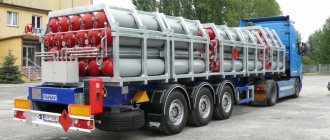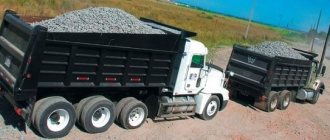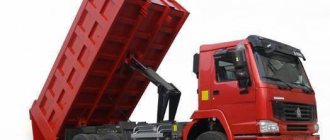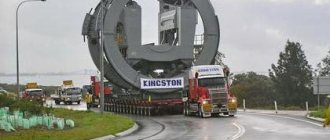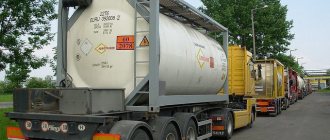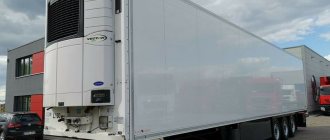Bulk goods are dry goods transported without containers - in bulk. According to the transport classification, bulk cargo is a type of cargo that is dangerous due to the possibility of displacement, and is divided into two classes - non-grain and grain.
The specific properties of bulk cargoes can be divided into physical, chemical and biological. Physical properties include: flowability, ability to shrink and self-sort, thermal conductivity, abrasiveness. Chemical properties include: self-heating, spontaneous combustion, explosion hazard. Only grain cargoes that continue their life activity have biological properties. Bulk cargo can be in three transport states: relatively solid, loose and liquefied.
The first state is typical for loads with an angle of repose of more than 35°; third - for ore concentrates and similar cargoes at high humidity.
Bulk cargoes have free spaces inside the pieces (pores and capillaries) and between the pieces (wells). Therefore, the volume of the load Vв is composed of the volume Vп of the substance of the pieces themselves, the volume of capillaries and pores Vс and the volume of wells between the pieces V:
V = V in + V p + V c
In connection with these features of the structure of bulk cargo, several types of its density are distinguished:
- pв – density of the bulk cargo substance, defined as the ratio of the mass G of the cargo to the volume Vв of the cargo substance;
p in = GV in ,
- pо – volumetric mass of bulk cargo, is defined as the ratio of the mass G of the cargo to the total volume of the substance Vв of the cargo and capillaries Vп in all particles of the cargo.
p o = GV in + V p;
Kp – porosity, is defined as the ratio of the volume of pores and capillaries Vp.o to the volume of the particle itself:
K p = V p. about V century. o + V p. O .
The Kp value determines how much moisture the load can absorb when it is wetted;
p – bulk mass of bulk cargo is defined as the ratio of the mass G of the cargo to the total volume V of the cargo;
p = GV = GV in + V p + V s.
Classification
The classification of cargo depends on many parameters, among which are the following:
- difference in loading and unloading methods: liquid, piece (packaged) and bulk;
- difference in delivery methods: universal (for their transportation, regular on-board transport is required), liquid, bulk bulk (loading is carried out in bulk, transported by dump trucks), special (specific, require special precautions), bulk other (transportation is carried out on ordinary on-board vehicles);
- according to weight characteristics;
- according to the degree of danger;
- according to storage conditions.
Products are transported using various types of packaging: boxes, bags, containers and various packaging. But there are options in which goods can only be transported in bulk. These are so-called non-packaged goods, which come in two types:
- Bulk, characterized by a homogeneous composition and a small fraction. This definition corresponds to: grain, sand, gravel, cement and a number of cargoes similar in composition.
- Bulk or bulk cargo that does not require special containers for transportation and storage. They are not part of the bulk. The difference lies in the presence of specific physical properties such as shear resistance.
Gravel and cement are classified as bulk cargo
Document overview
It is planned to update the rules for the transportation of goods by rail in bulk.
Cargo will be transported in bulk, the loading of which is carried out with or without stowage in a wagon and which, due to its physical properties or geometric dimensions, cannot be classified as bulk cargo. In this case, the shipper will be obliged to indicate the number of pieces of cargo to be transported in bulk in one car, if it does not exceed 100 pieces. If there are more than 100 such items, these goods are presented for transportation indicating the number of items at the request of the shipper.
Cargo that requires protection from precipitation and blowing will be transported in bulk and in bulk, including in universal covered wagons and gondola cars using wagon liners.
Bulk and bulk cargo, formed into transport packages, will be transported taking into account the relevant rules. To transport such goods in packaged form, formed into transport packages, or without forming them into transport packages, it will be possible to use covered wagons.
Source
Bulk cargo
They consist of a large number of small particles. In most cases they are homogeneous in their composition, but sometimes they can be heterogeneous (differ in size). They belong to bulk, but due to certain physical properties they are a separate subgroup.
If bulk cargo consists of homogeneous particles (granules, pieces), then bulk cargo is a heterogeneous mass of small particles with enormous mobility. A so-called shear occurs, which is formed due to the resistance to friction of small particles on the sliding surface.
Transportation of bulk products is associated with a number of dangers:
- possibility of “dry displacement” or movement;
- threat of liquefaction or overflow;
- there is a possibility of spontaneous combustion;
- the appearance of poisonous gases and gases capable of exploding in the hold space;
- accelerated metal corrosion;
- violation of the strength of the vessel.
Bulk cargoes do not pose a danger when packed in barrels or containers, which cannot be said about bulk cargo. They are delivered in bulk, in one batch, by special transport.
Bulk products cannot always be packaged. Large masses of grain when stored in bags tend to self-heat and may subsequently ignite. Open transportation of grain in bulk prevents this danger, since the grain is ventilated in the air and is not subject to debate.
Some goods should be transported openly, without containers
According to the conditions of transportation and storage
High-quality transportation means not only timely delivery from the supplier to the recipient, but also maintaining the quality of the goods and their volumes. All cargo is divided into 2 large categories - ordinary and specific. The requirements for the vehicle depend on the category of goods being transported, a package of documents is formed, and permits are established for drivers and forwarders. Each product has its own delivery time. For example, fruit or live cargo must be delivered quickly and carefully without causing harm. And frozen products can be in transit for many days, provided that the temperature is maintained.
For ordinary cargo, awnings and flatbed bodies are more often used; transport can be supplemented with trailers and semi-trailers.
Regular cargo
Ordinary cargo means goods, products, products that do not require special storage and transportation modes. For transportation, you can use any suitable vehicle with sufficient carrying capacity.
Specific cargo
This category of circles implies non-standard dimensions, extra-large weight, and special conditions of transportation and storage. Transportation may require additional accompanying documents, escort, control of the temperature inside the body, and the need for especially careful handling of the packaging. The category of specific cargo includes live cargo, perishable food and medicine, as well as dangerous and unsanitary cargo.
Oversized cargo
Transportation of goods with non-standard dimensions requires special permission and the organization of increased security measures along the route of transport. Due to non-standard parameters, such cargo is problematic to transport in vehicles not equipped with additional equipment.
For transportation by rail, cargo with the following dimensions will be considered non-standard:
- length more than 14 m;
- width exceeding 3.25m;
- height over 5.3 m.
These dimensions, when transported in standard cars, will create interference or interfere with loading, and therefore will require the organization of special conditions and a train platform.
For transportation by road, the parameters of oversized cargo are:
- length more than 20 m;
- width - 2.55m;
- height over 4 m.
The carrier will be required to maintain a certain speed limit to prevent rollovers and other problems with the platform. Also, when transporting such cargo, it is necessary to lay out the route in such a way that there are no bridges or overpasses along the way that the transport could not pass under freely.
Long cargo
If the overhang exceeds 2 meters beyond the tailgate, this category of oversized cargo is transported using single-axle trailers. If the length of the hanging end of the load is excessively long, a spreader trailer is used.
Heavy cargo
Cargo that requires transport with a large carrying capacity is called heavy cargo. These are objects with a mass of more than half a ton (500 kg).
Loads with a large mass are considered to be:
- roll-and-barrel – up to 500 kg;
- piece - up to 250 kg;
The usual mass is considered to be objects up to 80 kg.
Dangerous goods
This category includes liquid, solid and gaseous substances that require special storage conditions and transportation modes. The peculiarity of this category of cargo is the possibility of explosion, spontaneous combustion, leakage with subsequent poisoning and environmental pollution and the death of living organisms. Moreover, the reaction can begin both during transportation and at rest.
According to the established regulations GOST 19433–88, there are 9 classes of dangerous goods:
- Class “Explosives”: capable of spontaneous combustion and spontaneous detonation during transportation or storage. There are 6 categories with different levels of danger. This includes pyrotechnics, ammunition and their components, gunpowder, ammonal, TNT and others.
- Class "Gases". Includes 6 subgroups in compressed and liquefied states. Gases are divided into poisonous, flammable, and non-flammable. These include ammonia, mustard gas, oxygen, nitrogen, propane.
- Class “Flammable liquids”: this includes 3 categories of substances. Examples include fuels, paints and related solvents, and perfumes.
- Class "Solid flammable substances" (except for explosives). Includes 3 categories. This includes substances capable of spontaneous combustion upon contact with air, compositions and products that can themselves ignite or heat up when stored and transported in large volumes over a long period of time.
- Scattered grain and fish meal, household matches, and bales of cotton, which appear to be safe at first glance, are capable of spontaneous combustion.
- This also includes napalm, activated carbon, coal, phosphorus modifications, and aluminum powder.
- This class also includes gases that, when combined with water, can actively release oxygen - these are metallic sodium and carbides.
- Class: “Oxidizing substances and organic peroxides. Their peculiarity is the stimulation of the combustion process due to the release of oxygen. This class includes 2 categories, prime examples of substances are chlorine bleaches, nitrate, hydroperite.
- Class "Toxins and infectious substances". Potent substances that contain toxic compounds that can cause intoxication of the body, contamination of the environment, and death of plants and living beings. A total of 4 categories are included.
- Class "Radioactive substances". This includes instruments, flaw detector parts, and medical supplies.
- Class "Corrosive and caustic substances". Includes 3 categories - caustic substances, solutions of acids and alkalis. If it comes into contact with metal products, it causes corrosion. If handled carelessly, they will corrode the skin.
- Class "Other hazardous substances". Combines substances and industrial products that are not included in the previous 8 classes, but pose a danger when transported by water in bulk. This includes cars, motors, magnets, asbestos, dry ice, strong odors and life-saving equipment.
The documents for the cargo must include a hazard class, and the vehicle is marked with the appropriate sign. There are cargoes that require increased security measures; they are transported with escort.
If one transport unit is loaded with dangerous goods of different classes, their combination must comply with the established rules for the transportation of dangerous goods.
Perishable goods
This category of cargo requires fast delivery and special temperature conditions. Here, the carrier is obliged to comply with the rules of the commodity neighborhood and control the temperature regime and air flow established for the transported products, if the requirements stipulate the ventilation of the body.
If transportation is carried out in a refrigerator, the system maintains a range from -20oC to +15oC. Perishable goods are divided into 4 transportation classes in accordance with storage conditions and temperature conditions:
- ventilated - need to ensure air flow on a constant basis;
- refrigerated;
- chilled;
- frozen.
Vehicles for transporting perishable products and goods must be equipped with a sensor system that allows them to quickly monitor temperature fluctuations.
Unsanitary cargo
This includes dusty substances, household and industrial waste, wastewater treatment and sewage disposal products. Unsanitary cargo is transported in specially equipped vehicles. This category of cargo requires special storage in tanks, tanks, and tight packaging to prevent environmental pollution.
Live cargo
Large and small farm animals are most often transported in vehicles specially equipped for these purposes, accompanied by a specially trained forwarder. When transporting, each head must have veterinary documents.
- The poultry is transported in special cages;
- bees - in hives or special containers that allow maintaining conditions for the safety of insects and carriers.
- Live fish are transported in special tanks equipped with compressors for an uninterrupted supply of oxygen.
Properties
Bulk cargoes are divided into groups and subgroups based on their properties and types. Group A includes those that are capable of liquefaction and “dry displacement”. Group B includes loads with a risk of one “dry displacement”. If a product tends to spontaneously ignite or emit toxic gases, it is additionally designated with the index C.
All bulk cargo is transported according to certain rules:
- Since grain tends to easily absorb odors, it is necessary to maintain ideal cleanliness, absence of dust and odors on the transport used.
- It is necessary to maintain the required level of humidity so that the grain does not become moldy or swell during transportation.
- Compliance with a certain temperature regime at which the product cannot ignite and deteriorate.
- The presence of tightness guaranteeing the safety of the goods.
Delivery of bulk cargo is carried out by special transport: dump trucks and simple flatbed trucks equipped with steel or aluminum bodies are used. When choosing a transportation method, it is necessary to take into account its economic benefits. Delivery in bulk is most convenient.
When transporting certain types of bulk cargo, it is important to consider weather conditions. Snow and rain can ruin their quality. Mineral fertilizers or lime must be protected from moisture. Strong winds can blow away some bulk cargo. Therefore, for safety, it is recommended to use a special awning or tarpaulin.
It is convenient to transport bulk products by rail in special hopper cars. The use of special vessels (bulk carriers) is used to transport bulk cargo. It is necessary that the ship has under-deck voids, and the stability of the ship is guaranteed.
Hopper car for transportation of bulk cargo
Document overview
For the period from March 1, 2022 to March 1, 2028, new rules for the railway transportation of bulk and bulk goods were approved. They will replace the 2016 rules.
The list of goods is determined by the Ministry of Transport. A railway consignment note must be issued. Cargo that requires protection from precipitation is transported in universal covered wagons, in specialized covered wagons, in specialized containers, as well as in universal gondola cars in packaged form. Requirements for the transportation of specific types of cargo are specified.
Source
Types of bulk cargo
By definition, bulk cargo includes:
- Different types of sand.
- Construction crushed stone and stone obtained from crushing rocks. Among them, granite is the most famous.
- Cement.
- Gravel mass, which is fragments of rocks and minerals, the size of which is from 5 to 10 mm.
- Mineral fertilizers (granules).
- Peat, the formation of which occurred due to the accumulation of mosses that decomposed in swamps. Carbon content is 60%. It is an excellent fuel and fertilizer.
By type, bulk cargo can be classified as lumpy, dusty or granular. Data such as particle size play an important role in their determination. It should be in the range from 0.1 to 10 mm.
Sand is one of the most common bulk cargoes
Sand
Sand is a loose rock composed of various minerals. It can be clayey, coarse-grained or dusty and is the best building material. Divided into several types:
- River sand is a natural material extracted from the river bottom. It is characterized by the highest degree of purification, so it does not require additional processing methods. It has no clay inclusions and is an ideal building material. There are large types of river sand, medium and fine. Good to use as planting soil and for landscape design.
- By definition, sea sand is a collection of tiny particles of hard minerals mined from the seabed.
- About quarry sand we can say that it is mined in ravines or quarries.
- These bulk loads consist of particles of clay, stones and dust. Used in the production of concrete and well rings.
Carrying out work involving the use of bulk cargo requires special care and compliance with safety precautions. The rules for transporting such products are regulated by law.
